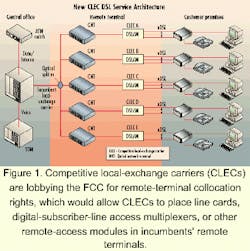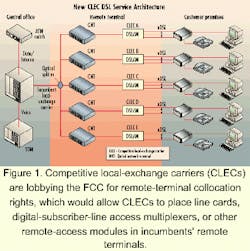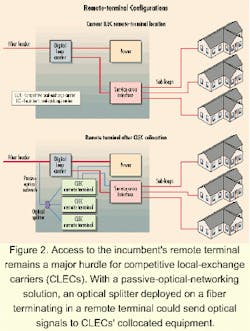PON solution to the remote-terminal access dilemma
CLECs want access to incumbents' remote terminals. As the FCC weighs three options, passive optical networks offer another approach.
Jim Holley
NEC Eluminant Technologies Inc.
The long-awaited "next-generation" telecommunications network infrastructure is already in view. New and legacy network backbones and metropolitan area networks now feature the latest technology for low-cost, high-capacity, and high-reliability transmission of voice and data services. The public-switched telephone network (PSTN) is also increasingly optical, even as the subscriber loop, interexchange, and long-haul portions of the network become a tapestry of interwoven competitors and technologies.
A key gap to be bridged in the new network's evolution is access to subscribers through remote terminals deployed by incumbent local-exchange carriers (ILECs). With more than 100,000 in place across the country, these terminals are the network access points for millions of subscribers located too far from central offices for direct connection. Some 25% of individual subscribers on the PSTN are served via remote terminals-each of which can handle 1,000 or more subscribers, but in most cases serve only a few hundred.
To help generate competition for the provisioning of broadband services in the local loop, new carriers-particularly competitive local-exchange carriers (CLECs)-need access to these remote terminals, just as they have been granted access to ILECs' central offices. The cost of deploying new connections from central offices to individual subscribers is otherwise prohibitive.
Currently, the Federal Communications Commission is evaluating three options that would allow non-incumbent carriers to offer services cost-effectively to subscribers now served through ILECs' remote terminals:
- Resale of incumbent LEC-provided advanced services.
- Purchase of unbundled network elements and collocation of CLEC equipment in ILECs' remote terminals.
- Adjacent collocation of CLEC equipment and interconnection to the ILECs' remote terminals or serving-area interfaces.
The Common Carrier Bureau is now evaluating input from the session. The agency is also looking at the remote-terminal question within the framework of various regulatory matters before it, including the mergers of SBC Communications and Ameritech and Bell Atlantic and GTE as well as the collocation remand. Members of the FCC staff are now working on the collocation order, and the full commission is expected to vote on it sometime this year.
Some industry observers believe that the FCC will find compelling reasons to come out in favor of collocation in remote terminals. "I think there's a lot of pressure on the FCC to open up access," says Andy McCormick, an analyst with the Aberdeen Group (Boston). "I think the FCC is going to mandate that terminals be opened up so that people see some tangible benefits such as reduced costs and increased competition from the Telecommunications Act."
An attractive alternative among the three options under consideration by the FCC is the collocation of CLEC equipment in the remote terminal.
In many cases, there are extra copper connections and optical fibers from remote terminals back to the central office. These fibers and copper wires could be leased or otherwise made available to competitive carriers. Copper wires, however, tend to be older and in poor condition. For this reason-and due to surging demand for broadband transport-solutions that bring optical connections to terminals are attracting the most attention, and the FCC is likely to favor models that advance optical penetration in networks.
As the agency stated in its public notice regarding its May public forum on competitive remote-terminal access, "We commend the efforts of those carriers that are deploying fiber deeper and closer to customers to meet the escalating demand for greater bandwidth."
The issue of which remote-terminal option will be required or advocated by the FCC remains extremely contentious among the incumbent and competitive LECs.
The United States Telephone Association (USTA) stated in a recent announcement, "Incumbent local telephone companies have no obligations under the Telecommunications Act of 1996 to collaborate with competitors on network deployment decisions. Incumbents are only required to make their networks accessible under Section 251 of the Telecom Act. They are not required to consult with competitors prior to making decisions about deployment of network infrastructure."The USTA also contends that it is "beyond the FCC's authority to dictate" decisions on network deployment. (See USTA's May 10, 2000 release at www.usta.org/rls00-16.html)
Through the Association for Local Telecommunications Services (ALTS), CLECs advocate that the FCC require ILECs to grant access to their remote terminals. Specifically, ALTS is lobbying the FCC to allow CLECs to place line cards, digital- subscriber-line access multiplexers (DSLAMs), or other remote-access modules in remote terminals (see Figure 1).
While the remote-terminal question is still up in the air, the FCC has made a decision on a related matter. It has ruled that if an incumbent carrier has an "extra" optical fiber available between a central office and remote terminal, the incumbent must make the fiber available to competitive carriers.
But it's unlikely that many "extra" fibers are available. So, if multiple new CLECs wish to gain access, many of these carriers will have no choice but to deploy new fiber from central offices to remote terminals.
An efficient way around this dilemma is to deploy a passive-optical-networking (PON) solution-specifically a splitter, which can take a single fiber and allocate an optical signal to as many as 64 separate channels. In this case, a splitter deployed on a fiber terminating in a remote terminal could send optical signals to CLECs' equipment collocated in the remote terminal (see Figure 2).
Although new, this solution has had limited deployment in the United States. for residential customers and in cable-TV networks. Such PON solutions have been used more frequently in Japan.
Deployment in the United States and overseas should get a boost from the adoption last year of the Full Service Access Network standard by the International Telecommunications Union. In the United States, PON products and systems based on the standard are coming to market this year and early next year.
"PON solutions could also be used to deploy fiber from remote terminals to the curb or pedestal for residential applications or directly to office buildings for businesses," says Alex Benik, an analyst with the Yankee Group (Boston).
If the FCC does grant remote-terminal collocation rights to non-incumbent carriers, there are other questions to resolve before PON solutions can be deployed.
The first is a simple question of "real estate." Namely, is there enough space in remote terminals to allow installation of CLECs' PON connections as well as the electronics needed for individual subscriber services?
If space is insufficient, then CLECs will need to install new environmentally protected cabinets or controlled environmental vaults adjacent to incumbents' vaults and cabinets.
That, however, will raise right-of-way issues with municipalities that are not eager to see more telecommunications gear sprouting up in neighborhoods. The FCC, however, could take steps to encourage and educate municipalities about the need for this new equipment for broadband technology to become universally available.
As with the question of remote-terminal access, resolution of local right-of-way issues will be critical to determining the future of the PSTN.
Residential and business demands for more bandwidth and more advanced services-at competitive costs-will continue to accelerate the deployment of fiber-optic technology, pushing the optical edge closer and closer to the end-customer. For serving small clusters of remote subscribers, PON technology presents an option-and perhaps an opportunity-that can't be overlooked.
Jim Holley is the senior vice president of marketing for NEC Eluminant Technologies Inc. (Herndon, VA). The company's Website is www.eluminant.com.


